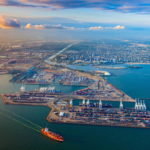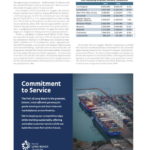Quite a few ports in the United States reported growth and positive balances recently.
But despite positive circumstances and good prospects, they urge the Federal Government for huge investments. By Michael Meyer
According to figures presented by AAPA (American Association of Port Authorities), U.S. seaward trade increased by 10% within the first[ds_preview] eleven months of 2017. »Overall for 2017, foreign trade tonnage was the highest it’s been since 2008, with exports experiencing double-digit growth to a record high and the fourth consecutive year of gains for imports,« AAPA President Kurt Nagle told HANSA.
Experts continue to caution infrastructural deficiencies may slow down the US economic boom. Even though the Trump administration has introduced a comprehensive investment package to Congress recently, an agreement with the Democrat opposition is not expected. Some Republican party members also expressed reservations. After the Panama Canal expansion, ports consider being prepared for the launch of large container ships one of the most important issues – not merely in terms of quayside handling. Port and hinterland processing of cargo also poses problems for the operators. Traffic jams and blockages are the result cargo owners and freight forwarders complain about. In addition, ports need to invest in green technologies as harsher regulations require a reduction in emissions.
Rather positively, AAPA is looking at political achievements: »AAPA is looking forward with great anticipation to a focus on America’s infrastructure investment needs by the Trump Administration and Congress in 2018,« Nagle says.
Seaport cargo activity accounts for 26% of U.S. GDP, over 23 mill. American jobs, and generates over 320 bn $ annually in federal, state and local tax revenues. To ensure these jobs, tax revenues and freight volumes continue to grow and support the American economy, AAPA has worked to identify 66 bn $ in federal port-related infrastructure investments over the next ten years, on both the waterside and the landside. This level of federal investment into port-related infrastructure is needed to support the nearly 155 bn $ in infrastructure investments that U.S. ports and their private-sector partners plan to invest up and including 2020. Federal support for land and waterside infrastructure improvements, together with security and environmental protection, are key priorities for America’s ports in 2018 and beyond.
Nagle adds, »AAPA member ports are pleased that the Congress continues to provide strong funding for the Corps’ Navigation program, including making progress towards full use of annual Harbor Maintenance Tax (HMT) revenues.« The association is also advocating congressional appropriations in other programmes for freight transportation, port security, diesel emissions reduction grants, additional customs and border protection.
As part of the »Tax Cuts and Jobs Act« bill passed 2017, AAPA says it was successful in urging Congress to maintain most tax exemptions on Private Activity Bonds (PABs) to help finance infrastructure projects. The association’s advocacy efforts also were rewarded when Congress voted to maintain the tax credit for wind energy projects. Because PABs provide a significant source of financing for port-related and municipal infrastructure projects, AAPA worked with several transportation and bond-related coalitions to advocate against the elimination of tax exempt status for PABs. »We were extremely pleased the final legislation kept PABs mostly tax-exempt. Maintaining PABs as tax-exempt will help foster investments, not just in and around ports, but also in needed infrastructure development throughout the nation. It was estimated that ports would have had to pay approximately 19mill. $ in extra debt service costs for every 100mill. $ borrowed had the PAB tax exemption been lost. These significantly increased costs would have harmed ports’ ability to make needed investments, and likely would have delayed or even killed some projects.
As Congress and the Trump Administration consider a broad infrastructure investment package, U.S. seaports have identified 66 bn $ in necessary infrastructure investments over the next decade to keep freight moving efficiently. On the waterside, this works out to about 33.8 bn $. On the landside, the amount is estimated to be 32.03 bn $. On the waterside, there is a need for 27.6 bn $ to maintain channels and harbours, and 6.2 bn $ to modernize them. Of the 27.6 bn $, 18.6 bn $ would come from full use of annual HMT revenues, which includes providing more equity to donor ports, plus 9 bn $ from the current HMT surplus to address the chronic dredging maintenance backlog at deep-draft ports. Of the 6.2 bn .$ modernization amount AAPA has identified, 3.1 bn $ is needed for the federal share of 15 current congressionally-authorized construction channel improvements and another 3.1 bn for the federal share of constructing projects undergoing feasibility studies.
For the landside portion of the infrastructure investment need, 28.9 bn $ is necessary up and including 2025 to build vital road and rail connectors, plus 3.13 bn $ to improve port infrastructure, allowing more funding for multi-modal freight projects. »A top priority, going forward, is getting Congress to make HMT spending mandatory, while addressing donor equity and tax fairness issues,« the AAPA President explains. Because U.S. ports and their private-sector partners have told AAPA they plan to invest some 155 bn $ into port-related infrastructure and other capital projects between 2016 and 2020, AAPA says to continue to urge the Federal Government to make the 66 bn $ in port-related investments.
First automated terminal in L.A.
The supporting circumstances – the booming U.S. industry and the expanded Panama Canal, just to name two – led to very positive results for quite a few U.S. ports in 2017.
One example is West Coast hub Los Angeles, the nation’s busiest container port, which is coming off of back-to-back record-breaking years. In 2017, the container port saw a throughput of 9.3mill. TEUs, a 5.5% improvement over 2016’s record year. »We’ve had an extraordinary run these last two years, and we are optimistic about 2018. Record cargo numbers are providing us the opportunity to invest more in our port infrastructure,« a spokesperson tells HANSA. To adapt for future challenges, Los Angeles is working on several expansion projects.
TraPac, a subsidiary of Japan-based Mitsui O.S.K. Lines, has expanded through a five-year, 510mill. $ programme that has extended its wharves to 4,600 linear feet, deepened water depth at Berths 144–147, installed new cranes, upgraded and electrified backlands, constructed road and gate improvements and terminal buildings, and built a new on-dock rail facility. All programme elements have been constructed and the terminal is now operating with new electrified equipment. »Construction of on-dock rail and the final phase of backland improvements were completed in 2017, making the Port of Los Angeles home to the first automated terminal and rail facility on the West Coast,« the spokesperson adds.
In October, the Los Angeles Harbor Commission certified the Final Environmental Impact Statement for the proposed improvement project for the »Everport Container Terminal Improvements Project«. Everport’s proposed plan is to deepen its berths and improve its terminal facilities, allowing the terminal operator to accommodate the larger next-generation vessels. The 58mill. $ project would increase berth depth up to 53 feet. Construction is expected to start in late 2018.
600 mill. $ for rail in NY/NJ
Completion of the Bayonne Bridge Navigational Clearance Project last June helped drive cargo volumes in the Port of New York and New Jersey to new record heights in 2017 by shattering the existing annual cargo volume record, set in 2015, by 5.3%. In addition to regional economic growth, the bridge project was perhaps the biggest driving force.
During 2017, the port handled 6.71mill. TEUs. The record volumes allowed the port to maintain its position as the third largest port in the United States with 15.4% market share and the busiest on the East Coast with a 32% market share, according to the port authority.
The project raised the clearance under the crossing from 151 feet to 215 feet, allowing ships as large as 18,000TEUs to travel under it to port facilities in Newark, Elizabeth and Staten Island. Since the project’s completion, the port has set new monthly records for cargo volume activity every month through the remainder of the year.
In addition, ExpressRail, the port authority’s ship-to-rail system, also set a new record, handling 567,649 container lifts, a 5.1% increase over the previous record in 2016. In 2017, ExpressRail accounted for 14.8% of all container lifts at the port. The Port Authority’s goal is for the ExpressRail system to account for 20% of container lifts by 2020. To achieve this goal, the agency has invested more than 600mill. $ in its intermodal rail infrastructure. »The new ExpressRail Port Jersey intermodal facility will be operational in December 2018. The completion will add 250,000 lifts per year in rail capacity to the port, yielding a total port-wide capacity of 1,500,000 lifts per year,« a spokesperson confirms.
Record year in Long Beach
The Port of Long Beach moved 7.54mill. TEUs in 2017, the most in the 107-year history and an 11% increase over the previous year. For the port, the big story was the »dramatic turnaround at Pier T, under the new marine terminal operator MSC, which had a very busy year,« Executive Director Mario Cordero tells HANSA. Before declaring bankruptcy in August 2016, Hanjin Shipping, which leased Pier T, accounted for 12% of the Long Beach’s container volume. »Along with the success of MSC at Pier T, we also welcomed the return of Hyundai. SM Line, a carrier created out of the bankruptcy of Hanjin, brought its first ship to the Pier A last year and is thriving,« he adds.
In addition, he also saw the opening of a second berth at the Long Beach Container Terminal at Pier E, which is being redeveloped and opened its first berth in 2016. According to Cordero, the advanced technology at the terminal is operating well and achieving near-zero emissions. Given the forecasts for increases in international trade and retail activity, he expects volume to increase in 2018. »We would look at an increase of at least 3%. So we expect an increase in trade in 2018.« China is the source for about two-thirds of the imports, and the destination for about one-third of exports. »West Coast ports handle more than two-thirds of Asian cargo, and that has remained stable,« the Executive Director explains, adding »larger and larger ships are entering the trans-Pacific trade. We can handle the largest ships in the world and this region has the warehousing, rail connections and truck connections to service those ships.«
Asked about the impact of a potential »new« federal trade policy, Cordero emphasizes, that based on the strong global economy, he expects to see trade increase modestly this year through Long Beach. »It isn’t clear what new trade policies will be enacted«, he says. The port continues to modernize and improve the port »so we remain the premier gateway for U.S.-Asia trade. We are looking forward to a ›24/7‹ port featuring more information technology, one that is nimble like online retailer Amazon, and bold like electric vehicle builder Tesla. We must re-imagine, redesign and build a port that is second to none both environmentally and operationally,« Cordero says.
Jacksonville expects growth
In Florida, Jacksonsville’s port operator Jaxport reports, the public seaport terminals achieved record growth in containers, vehicles and overall tonnage during the fiscal year ending 30 September 2017. Jaxport moved more than 1mill. TEUs, a 7% increase over 2016, which had also been a record year. »We expect increased throughput and revenue as well as increases in both our vehicle business and heavy/lift project cargoes and we expect continued growth in our container and vehicle segments meaning boosts in our Asian, European and Mexican trade volumes,« the port operator tells HANSA. Asked about the potential impact of the »new« trade policy of the U.S. government, it is explained, that trade policies may prompt companies to build in the U.S., »positively impacting our export volumes.«
Jaxport is set to begin construction of a new automobile processing terminal, the first phase of a multi-year project which will increase the vehicle-handling capacity by 25%. The expansion follows a year of record vehicle volumes. In 2017, the port moved 693,000 total units, the most in its history. When combined with the containers handled through private terminals, more than 1.3mill. TEUs containers were handled. According to the port authority, the Asian container trade continues to be the fastest growing segment, achieving 19% growth in the past year, with nearly 400,000 Asian containers moved.
However, the port plans to expand the infrastructure in order to be ready for future challenges. The federal project to deepen the Jacksonville shipping channel to 47 feet to accommodate even more cargo aboard the largest ships is scheduled to begin construction later this year.
Binational record, too
The St. Lawrence Seaway is of great significance both for the U.S. and Canada. Since its opening in 1959, over 2.9 bn. t of cargo valued at over 450 bn $ has moved through the 15 locks. The Seaway Management Corporation (SLSMC) recently announced that robust economic growth brought about strong gains in a number of cargo sectors, with tonnage rising by 9% to over 38mill. t of cargo.
»From iron ore movements stoking both North American as well as Asian steel mills, to shipments of stone, cement and steel that enabled construction activity to keep moving at a brisk pace, the Seaway demonstrated its role as a vital binational transportation gateway supporting virtually every sector of the North American economy,« SLSMC said.
Michael Meyer






















